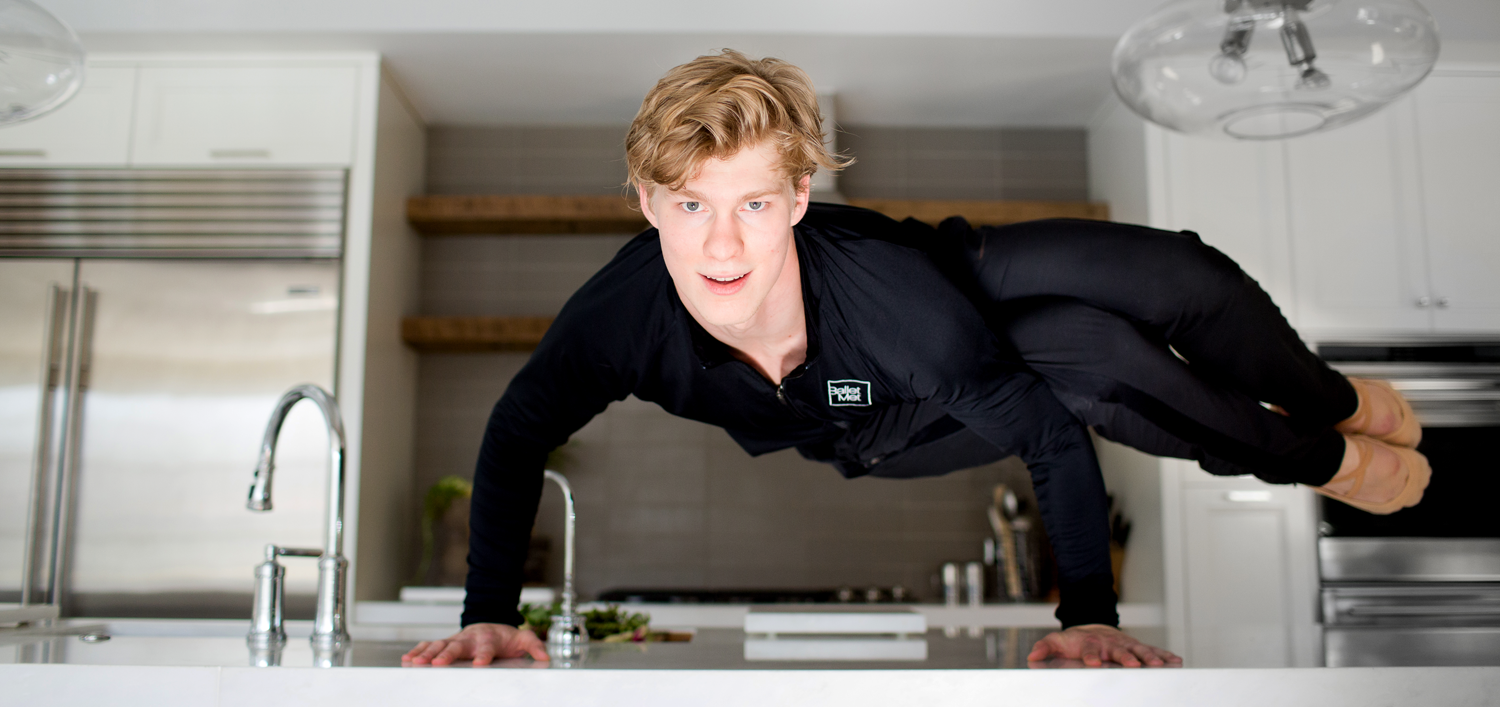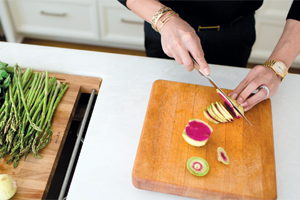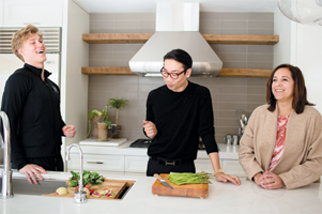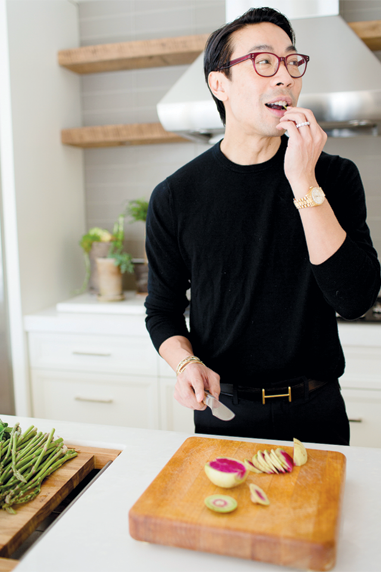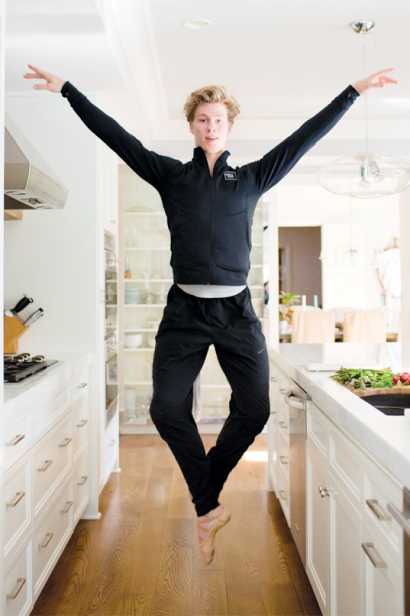Dancing Cooks
Food is more than fuel, as the saying, “You are what you eat,” suggests. Food is life, your life. So, for our “Food & Art” issue we were really excited to talk with our local ballet company, BalletMet, about what the dancers and choreographers eat for work versus pleasure and if they enjoy, let alone have the time, to cook. Our theory: Perhaps the dancing spirit arises not just because of ballet class every day, or long rehearsals at night, but as a result of what ballet artists savor in between their labors of creation.
From Dancer to Director
When we talk, artistic director, Edwaard Liang, is in between travels, having just returned from Milan and on his way to Hong Kong. He shares that he’s on the Whole30 program and that eating in Italy actually wasn’t that bad. His commitment to nutrition and clean eating, however, wasn’t always the case.
Native to Taiwan and raised in California, Edwaard joined the ranks of New York City Ballet (NYCB) in 1993. The foremost ballet company in America, NYCB didn’t yet offer nutrition classes for the dancers but did encourage healthy eating by having no tolerance for salty snacks and sugary drinks, placing a focus on eating fresh vegetables and protein throughout the day.
Like many beginning dancers, however, Edwaard got away with a lot.
“I was a young man in ballet and I could basically eat whatever I wanted to for a very long time,” he says.
The NYCB aesthetic focuses on very lean, muscular ballet bodies for the company. When Edwaard became a company member he had to eat to keep his form in shape, not just for the aesthetic, but also for the rigorous performance schedule.
“We were doing extremely heavy reps [repertoire], 45 ballets within 14 weeks,” he says. “So, it was about being able to find food that sustained energy all through the day.”
Now that Edwaard is a choreographer and artistic director at BalletMet his dietary needs are different. And it’s a challenge. Finding time to eat, even have a lunch break, is a constant work in progress, and not dancing all day presents the difficulty of finding time to get enough exercise.
“Most dancers are so used to sweating and exercising all day,” he says. “It was a big change because I went from meeting to rehearsal to meeting, and didn’t have the time to detox in a way where dancers are constantly sweating and getting that way of cleansing their body and resetting their metabolism.”
Eating for Ballet
So, what does it take nowadays to eat and be in a ballet company? Ambre Emory-Maier, director of education at BalletMet and associate director of BalletMet 2, says that nutritional therapies and counseling have come a long way since she started as a dancer and choreographer.
“The availability of clean eating and diet wasn’t truly available, and certainly wasn’t given to me as a dancer in my education,” she says.
Today at BalletMet she works closely with the BalletMet 2 dancers to make sure they are getting proper nutrition for the demands of a life lived on stage.
“We bring in Ohio State University for our trainees, and they do a series of seminars on nutrition and healthy choices and how to eat so you have the right fuel to make it through the day, to keep that lean muscle, to help recover from injuries,” she says. “And we have access to a sports nutritionist and counselors who help the professional and second company dancers do that.”
She says that advances in awareness around local, organic foods and nutrition have “taken a huge step forward in the last 30 years, to everybody’s benefit.” It also allows those with special dietary needs, like vegans, to properly manage what they need to eat to keep their bodies to the necessary proportions and have enough energy for a career in dance.
“I’m working with dancers in BalletMet 2 and they’re very aware of nutrition, a lot of them do practice clean eating,” she says. “They’re more attuned to that.”
A Kitchen Affair
We’re standing in the kitchen, eating and talking about everything from Instapots to the new little eater in Clintonville with Ambre, Edwaard and company member, Jarrett Reimers. Jarrett is a natural-born ballet dancer, but also a natural in the kitchen. When Edwaard asks him where he learned how to cook, he credits his roommate in California, who would launch into the kitchen with no recipe—all instinct—and deliver a delicious meal. It inspired him to use his own creativity when cooking.
Humble in his approach to eating at work (he says he keeps sandwich fixings in the fridge at BalletMet to make a sandwich in between classes and rehearsals), Jarrett also lives for dinner.
“Sometimes, at the end of the day, it’s the thing I’m looking forward to,” he says. “I just can’t wait to start cooking.”
His style “revolves around saving money, convenience and healthy eating.” He shops for meat or a vegetable on sale and then builds a dish around it. He has a well-stocked spice cabinet because, as he admits, “spices are the spice of life, and some foods need a lot of help.”
This one rule to cooking helps keep Jarrett creating in the kitchen.
“Sometimes limiting your scope is the best way to dig deeper,” he says. “If everything’s available, then you don’t really specialize as much as you could, and for making the best food that you can make and feeling like you did something excellent, you have to focus in.
“It’s the same with dance. If I want to do something very well, I can’t practice everything all week. I have to practice one thing all week to really improve and get that focus,” he says.
Tagging it as an “improvisatory approach” to cooking, Jarrett’s palate wins. Each year BalletMet holds a chili cook-off, and Edwaard tells me Jarrett nearly always takes the prize.
One year collard greens were on sale for 9 cents a bunch.
“I thought that was crazy. I made collard greens every way I could think. For inspiration, I sometimes pick different countries. I think how can I incorporate collard greens into an Indian dish, or a French-style dish, an Italian-style dish, just bring it around the world a little bit,” he says. This approach inspired his Collard Green Curried Chili, the winner that year.
When Edwaard and his partner, John, are home to cook they enjoy making roasted chicken with Brussels sprouts, or a Chilean Sea Bass with Miso Glaze. They love cauliflower rice, and have lately been making fresh stocks with beef or chicken and then creating a fresh chicken soup, or homemade French Onion soup. Edwaard is also first-generation Chinese and makes sushi or Korean at home, citing the amazing food markets throughout the city as sources for his menus.
“You definitely tap into a level of self-expression and artistry that we have in dance, and strangely enough you find it in cooking as well,” says Jarrett. “They’re both really special to me.”
Edwaard echoes the sentiment that cooking is a creative act.
“John and I enjoy the process, whether it’s a big dinner for family, friends, board members, community members. Picking out the menu, deciding on what we’re going to cook and how we’re going to add some flavor to it, having a glass of wine while we cook together; it’s also a time where we get to reflect and catch up on the week and check in with each other, have conversations, listen to music—it’s a perfect way for us to decompress. And it’s a ritual.”
Inspiration beyond the stage for the food lover in us all.
“Find the happiness in cooking because that’s the only time that you’re going to be making your best and learning the most, when you look inward for inspiration,” says Jarrett. “Learn from all the outward sources that you can, and then, most importantly, have a good time.”


